Middle East
‘Little guest’: How a rescued baby brought two Gaza families together | Israel-Palestine conflict
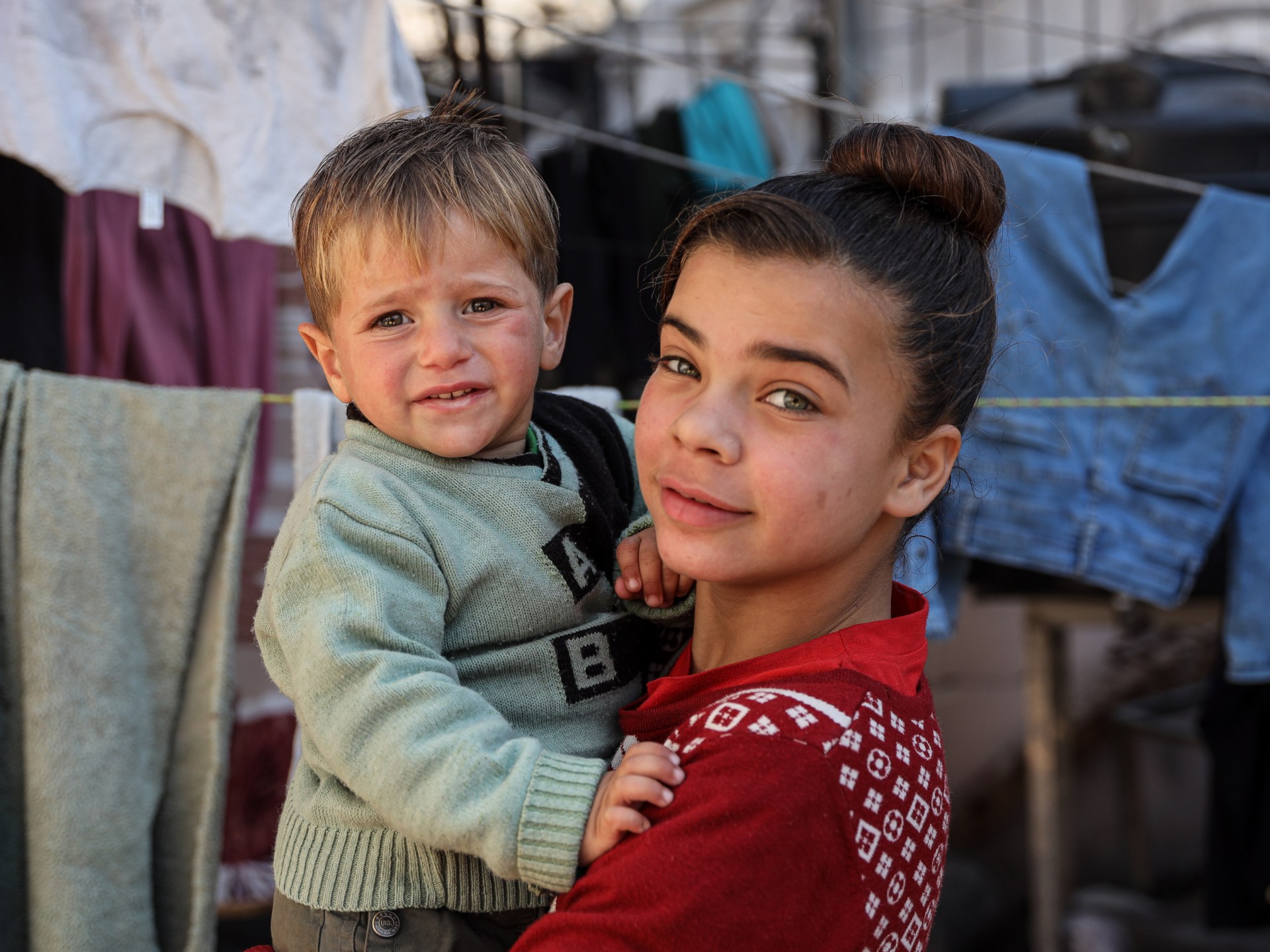
Jabalia, Gaza – Between the arms of his father and the family who cared for him during his disappearance, little Mohammed plays happily.
About 16 months ago, a 13-month-old Mohammed sat crying beside his mother’s lifeless body, surrounded by the dead and wounded, after an attack on the school the family was sheltering in.
That day, amid the chaos and fear as displaced families fled, he disappeared.
His father, Tareq Abu Jabal, spent more than a year looking for Mohammed while, unbeknownst to him, another man from the school was looking for Tareq.
‘A little guest’
Rasem Nabhan and his family were also displaced and sheltering in al-Rafei School in Jabalia in northern Gaza when two Israeli bombs hit it in late December 2023.
“We were terrified, the children were screaming,” the 41-year-old said. “Moments later, quadcopters appeared, broadcasting orders for everyone to evacuate immediately. There was gunfire everywhere.”
Rasem focused on getting his wife and seven children out of the school with the other women and children, then ran to help extinguish the flames still burning in the bombed classrooms. They needed to check if anyone was left alive.
![The story of the lost child in Gaza 2025 [Abdelhakim Abu Riash/Al Jazeera]](https://www.aljazeera.com/wp-content/uploads/2025/04/873A6295-copy-1744828206.jpg?w=770&resize=770%2C513)
“Blood covered the walls. … Body parts were scattered on the floor among the wounded and the dead. It was beyond words,” Rasem said.
Amid the carnage, he said, “I saw a baby crying and screaming. Next to him lay the body of a woman – her head and stomach torn apart, her body covered in blood. I think she was his mother.”
He picked up the child and ran, not thinking. “The baby’s face was red, and he could barely breathe, he was crying so hard.”
“I kept asking people around me: ‘Do you know this child? His mother was killed.’ But no one did,” he recounted. “It was impossible. … It felt like the Day of Judgement, everyone fleeing, clutching their children.”
Tanks had surrounded the school by then, he said, forcing everyone to walk south. Rasem walked with the baby in his arms until he reached his wife, who was waiting for him by the road with their children.
“I handed the child to my wife and told her I’d found him at the school with his dead mother,” he said.
Fawakeh Nabhan, Rasem’s 34-year-old wife, took the baby as her older daughters clamoured to be allowed to hold him.
“For a moment, the fear faded as we welcomed this little guest,” she said. “He had the most beautiful face, and I felt an instant connection.”
They nicknamed the baby Hamoud, the diminutive for Mohammed and Ahmed, two popular names, and took him along as they walked south towards Rashid Street, passing through the Israeli army’s Netzarim checkpoint.
They took turns carrying the baby – Rasem, Fawakeh and their two older daughters, 19-year-old Islam and 18-year-old Amina.
“He would fall asleep and wake up in our arms, like any other child, unaware of what was going on around him,” Fawakeh said.
Growing attached
The family didn’t know how old the baby was, but they guessed he was seven to nine months old, based on his size and weight.
“We’d never seen him at the school before and had no idea [about] his real age or when he was born,” Fawakeh added.
The family walked to central Gaza’s Deir el-Balah, resting there a while before continuing to Khan Younis in the south, where they had heard there were spots available at another school-turned-shelter.
“Despite the risks, I felt a school was better than living in a tent. At least we would have a concrete roof over our heads,” Fawakeh said.

The story of their displacements is long and complex because they moved from school to displacement camp to sleeping rough back to a tent for months.
Through it all, Rasem and Fawakeh saw the baby as a source of warmth and joy.
“At first, he was withdrawn and silent, never laughing, no matter how much we tried. For nearly 50 days, he was like that – as if he were searching for his mother and wondering who we were,” Rasem recalled. “But over time, he started to open up. He grew attached to us, and we to him.”
Throughout their displacement, Fawakeh, with Islam and Amina, cared for the baby. But when it came to feeding him, Fawakeh insisted on doing it herself.
But caring for a baby as Israel wages its genocidal war on Gaza is a huge financial strain because formula, diapers and nutritious food are either not available or are exorbitantly priced.
“When we arrived in the south, we bought formula and a pacifier, but he refused. I think he was breastfed by his mother,” Fawakeh said. “In a way, that was a relief because formula was expensive. Instead, I fed him lentils, beans, rice. He ate whatever we ate.”
“He loved bananas so much. We could only afford two – one for him and one for my four-year-old son, Abdullah.”
Diapers had to be rationed as their price skyrocketed, reaching 10 shekels a diaper (about $2.70).
“I would put one diaper on him at night, and during the day, I used cotton cloths that I changed frequently,” Fawakeh explained.
Blessings
As the family moved around, the baby became well known and adored, bringing blessings to the family, Rasem said.
Hamoud did not look like the Nabhans, and people would ask Rasem and Fawakeh about him. When they heard his story, their hearts would melt, and they would shower the little boy with whatever small gifts they could find.
“Our neighbours in the camp would send us plates of food just for him,” Fawakeh said with a laugh. “They would say, ‘Make sure he eats this.’”
![The story of the lost child in Gaza 2025 [Abdelhakim Abu Riash/Al Jazeera]](https://www.aljazeera.com/wp-content/uploads/2025/04/873A6285-copy-1744828233.jpg?w=770&resize=770%2C513)
“He calls my husband Baba and me Mama. He sleeps in my lap, runs straight to me when he needs comfort,” Fawakeh said, lowering her voice as she glanced at her youngest son.
“Abdullah, my four-year-old, would get so jealous and cry whenever I gave the baby too much attention.”
Overall, the couple’s children – Mohammed, 20; Islam, 19; Amina, 18; Maryam, 12; Nour el-Huda, 10; Mustafa, nine; and Abdallah, four – embraced the baby as one of their own.
Despite numerous offers from organisations, orphan sponsorship programmes and even other families willing to adopt the baby, Rasem refused.
“He is my eighth child. I love him deeply, and I refused the idea of someone taking him from me,” Rasem said.
“My answer was always firm: The only way I would ever let him go is if I found his real family.”
Then, in a hushed voice, he confessed: “But in my heart, I prayed I wouldn’t find them. I stopped searching. We had become too attached.”
A father’s search
As Rasem spoke, Mohammed’s father Tareq, 35, sat nearby listening, smiling at his youngest son.
The father of three – Omar, 14; Tolay, nine; and Mohammed, now 26 months – had never stopped looking for his missing child.
“On the day al-Rafei School was bombed, my wife and three children were inside our classroom,” Tareq recalled. “I was in the schoolyard when the air strike hit. I ran, screaming, towards them.”
The Israeli army had shelled both al-Rafei and the school next door. “In that strike, my wife, my nephew and six others were killed – eight lives lost in an instant,” he said.
“When I reached our classroom, I saw Omar and Tolay, both injured. Omar had shrapnel in his back, and my daughter had been struck in the stomach. Then I saw my wife. … Her body was torn apart.”
His voice faltered. “I collapsed. But somehow, I forced myself to help evacuate her body with the others.”
His wife, Iman Abu Jabal, was 33. Tolay carried shrapnel in her stomach for three months.
“Grief, fear for my wounded children, the screams, the rush to evacuate, the army’s drones circling overhead,” Tareq recounted. “In the panic, I didn’t take Mohammed with me when I carried his siblings out.”
When he went back for Mohammed, he couldn’t find him. The baby was gone.
“I started asking everyone,” he said. “Some told me he had been killed. Others said someone took him. The stories kept changing.”
![The story of the lost child in Gaza 2025 [Abdelhakim Abu Riash/Al Jazeera]](https://www.aljazeera.com/wp-content/uploads/2025/04/873A5680-copy-1744828194.jpg?w=770&resize=770%2C513)
“I was devastated. I searched through the crowds, but everyone was running, screaming, grabbing their children and fleeing,” he added.
He was not able to find his baby.
He went back into the school with a few others to bury the victims of the bombing.
“We wrapped my wife’s body in a sheet and waited for three hours in a classroom, unable to go outside to the yard to bury her,” Tareq recalled.
“The shelling and gunfire were relentless, but I wanted to bury my wife, no matter what.”
Among those who remained at the school was a surgeon who treated the wounded, including Tareq’s children, as best he could.
“My nephew was bleeding heavily. A young man helped him leave the school and walk to al-Awda Hospital in Jabalia, but he arrived in critical condition and passed away there.”
Tareq and the children spent the night in the school with the others who had stayed to bury their loved ones. In the morning, they snuck out through a gap in the school’s walls, taking detours to reach his brother’s house in western Jabalia.
After dropping the older kids off, Tareq spent the rest of the day searching the hospitals in Jabalia for Mohammed, then at the various spots where displaced people had gathered.
“I was told a family had taken him to the south while others hadn’t seen or heard anything about him.”
But Tareq also had to focus on his other children, traumatised by seeing their mother die and in need of food, medicine and care.
By the end of February 2024, northern Gaza was in the grips of famine, so Tareq decided to move south to save the children from the severe hunger sweeping the region.
As soon as he arrived in Rafah, Tareq resumed his search for Mohammed.
“I started asking relatives, acquaintances and neighbours who were with us in the school we had fled from, but I found no trace of him,” he continued. “I spent days like this until I lost all hope and turned to God.”
“I was seeing people fleeing, leaving their children behind in the bombings and evacuations. I saw children lost and crying. … It made me think about my child.”
![The story of the lost child in Gaza 2025 [Abdelhakim Abu Riash/Al Jazeera]](https://www.aljazeera.com/wp-content/uploads/2025/04/873A5779-copy-1744829776.jpg?w=770&resize=770%2C513)
Reuniting
On January 27, when displaced families were allowed to return to northern Gaza, the Abu Jabals and the Nabhans walked back to Jabalia.
“By 8am, my children and I were standing on the rubble of our home in Jabalia,” Tareq told Al Jazeera. “We had set out at 4am – we couldn’t wait any longer.”
Rasem and Fawakeh’s family headed out a bit later, and along the way, they were stopped for an interview.
“I talked about my joy to be going back. Then the journalist asked me about the baby, thinking he was my son and how he had grown up in the south,” Rasem recalled.
“I told her he wasn’t my son and explained his story. She was so moved, she made a plea on air for anyone to identify the child’s family,” Rasem added.
The family eventually got to Rasem’s parents’ home in Jabalia, not too far, as they would find out later, from Hamoud’s “real” family.
The next morning, Tareq came across the video from the TV interview.
“His features hadn’t changed although he had grown a little. I started shouting out across the rubble: ‘My son’s alive! My son Mohammed is alive!’
“My brother, his wife, the family and neighbours rushed over, asking what was wrong.
“We all watched the video together. Rasem’s face was familiar because we’d been sheltering at the same school.”
Asking around, Tareq figured out where Rasem’s family was staying and rushed over.
“Me, my children and brother went over, and I introduced myself to Rasem, who recognised me right away.
“Mohammed didn’t recognise me and cried,” he said, smiling in gratitude anyway.
The Nabhans were conflicted, happy that Hamoud, who they now knew was named Mohammed, had found his family but sad that he was leaving.
“It felt like I was giving away a piece of my soul,” Rasem said. “The hardest moment was when they left, and Hamoud was calling me, crying, ‘Baba, Baba!’”

“I spent the night crying from the sadness over Hamoud’s departure,” Fawakeh said, her eyes brimming with tears.
“My daughters cried for an entire week. The house felt like a wake. Hamoud had become a part of us,” Fawakeh added as she held the visiting Mohammed, who still calls her Mama, close.
“I told my husband and Tareq that Hamoud should come see us often. He’s like our son, and he’s very attached to me.
“Luckily, they live nearby, and my children always go to bring him over, so he can spend time with us. He brings us such joy,” she beamed.
Watching the Nabhans playing with his son, Tareq smiled. “I’m so grateful to them, from the bottom of my heart. They raised him as if he were their own. … He was with a family who showed him the love and care of the mother he lost.
“But as you can see, when Mohammed sees Rasem, his wife and their family, he completely forgets about me,” Tareq said.
“He loves them so much.”
Middle East
F1 Saudi GP: Piastri beats Verstappen, leads drivers’ championship | Motorsports News

Oscar Piastri’s victory put Australia on top of the Formula One world championship for the first time since 2010.
McLaren’s Oscar Piastri cruised to victory in the Formula One Saudi Arabian Grand Prix to move atop the driver’s championship after five races on the season.
The 24-year-old became the first driver this season to win while not starting on the pole, and he comfortably finished the race ahead of runner-up Max Verstappen of Red Bull, who was given a five-second penalty for leaving the track and gaining an advantage in the opening lap of the race on Sunday.
Charles Leclerc finished third to give Ferrari its first podium of the season. Piastri’s McLaren teammate Lando Norris finished fourth, while Mercedes’s George Russell finished fifth and Kimi Antonelli was sixth.
With his third victory of the season, and second consecutive after winning at Bahrain last week, Piastri becomes the first driver from Australia to lead the drivers’ championship standings since Mark Webber in 2010. It is the first time Piastri has led the drivers’ standings in his F1 career.
Piastri, who began the race from second position on the starting grid, ultimately took the lead on the 6.1km (3.8-mile) track after Verstappen served his five-second penalty during a pit stop on Lap 22. He finished off his fifth career victory in his 51st start without much of a challenge from Verstappen, crossing the finish line 2.84 seconds ahead of the reigning world champion.
In addition to 2025 race victories in Saudi Arabia and Bahrain, Piastri also won the second race of the season in China. McLaren has won four of the five races after Norris won the season-opening race in Australia.
Verstappen’s runner-up finish came after he won the Saudi Arabia Grand Prix in two of the last three years.
In the drivers’ championship, Piastri has 99 points to Norris’s 89 and Verstappen’s 87. Champions McLaren stretched their lead over Mercedes in the constructors’ standings to 77 points.

Middle East
Israeli army only finds ‘professional failures’ in Gaza aid worker killings | Israel-Palestine conflict News
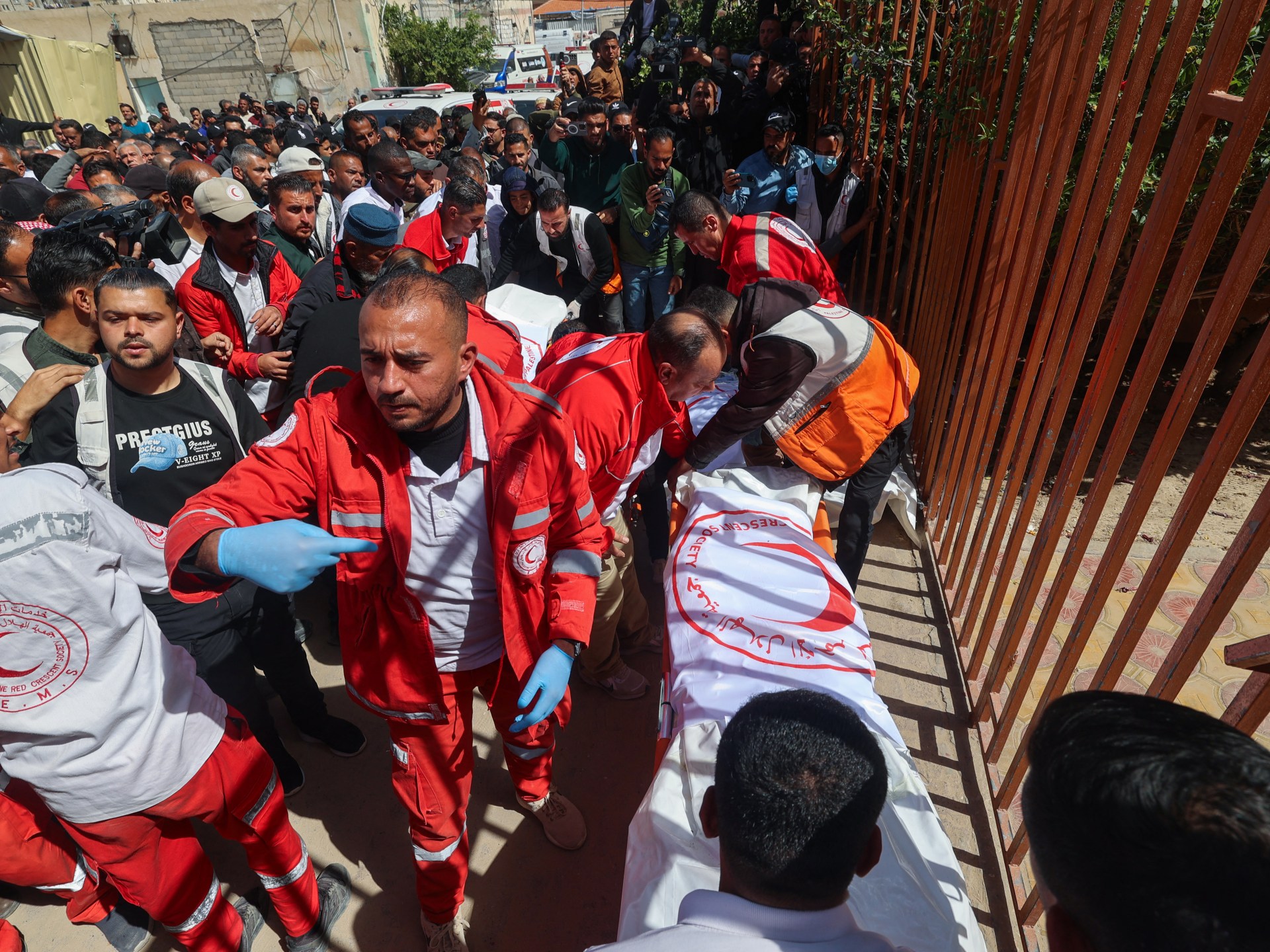
The Israeli military has released details of an investigation into its own killing of 15 Palestinian paramedics and aid workers in Gaza last month, saying its code of ethics was not violated and only one soldier is dismissed, in an attack that sparked outrage in the international community.
The Palestine Red Crescent Society (PRCS) and the Israeli rights organisation Breaking the Silence rejected the findings of the Israeli probe on Sunday.
PRCS’s president told Al-Araby TV that the Israeli narrative on the killings in Rafah was “contradictory”.
“It is incomprehensible why the occupation soldiers buried the bodies of the paramedics in a criminal manner,” Younis al-Khatib said.
Al-Khatib added that the Israeli army communicated with the paramedics before killing them and that the evidence – including a video showing their ambulances flashing emergency lights – proved “the falsity of the occupation’s narrative regarding the limited visibility at the site”.
“An independent and impartial investigation must be conducted by a UN body,” he said.
PRCS, which had medics killed by Israel in the incident, also denounced the Israeli report as “full of lies” on Sunday. “It is invalid and unacceptable, as it justifies the killing and shifts responsibility to a personal error in the field command when the truth is quite different,” Nebal Farsakh, spokesperson for the organisation, told the AFP news agency.
The PRCS said last week that it received confirmation from the International Committee of the Red Cross (ICRC) that one of its medics who was missing is being held by Israel.
🚨Urgent: We have been informed by the International Committee of the Red Cross that PRCS medic Assad Al-Nsasrah is being held by the Israeli occupation authorities. His fate had remained unknown since he was targeted along with other PRCS medics in #Rafah.
📢We call on the… pic.twitter.com/l0oOxujS8G— PRCS (@PalestineRCS) April 13, 2025
The Israeli army on Sunday claimed that six of the aid workers who were killed and buried in a shallow mass grave along with their ambulances were Hamas “terrorists”, without providing any evidence.
It admitted its probe detected a series of “professional failures”, including partial and inaccurate reporting by the commanding officers in the field invading southern Gaza’s Rafah.
The deputy commander of the Golani Reconnaissance Battalion will be dismissed, while the commanding officer of the 14th Brigade is to receive a reprimand.
The examination also found “no evidence to support claims of execution or that any of the deceased were bound before or after the shooting”, despite the testimonies and the evidence.
The Israeli military had initially claimed that the ambulances and aid workers were not clearly marked as first responders and approached its troops “suspiciously”.
A mobile phone video recorded by one of the killed aid workers that was obtained by the New York Times showed that the crew were clearly marked and visible to Israeli forces, and were killed by Israeli fire that lasted several minutes.
United Nations and Palestinian officials later found the mass grave and the bulldozed ambulances and bodies after Israeli authorities granted access to the area of the mostly destroyed city of Rafah bordering Egypt.
‘Another day, another cover-up’
The Israeli anti-occupation group Breaking the Silence said the military investigation is “riddled with contradictions, vague phrasing, and selective details”.
“Not every lie has a video to expose it, but this report doesn’t even attempt to engage with the truth,” the group said. “Another day, another cover-up. More innocent lives taken, with no accountability.”
But far-right voices in the government of Israeli Prime Minister Benjamin Netanyahu believe the army is going too far in punishing the soldiers.
Itamar Ben-Gvir, Israel’s ultranationalist national security minister, said the decision to dismiss the deputy commander was a “grave mistake” that must be reversed.
“Our combat soldiers, who are sacrificing their lives in Gaza, deserve our full support,” he said.

‘Report invites many questions’
Human rights lawyer Geoffrey Nice told Al Jazeera that the findings of the probe raise questions about the Israeli military’s conduct in Gaza and the thoroughness of the investigative process.
“It’s a pretty surprising document. It’s also a document that invites many questions that it will be difficult, I suspect, for the [Israeli military] to answer,” Nice said in a television interview.
“For example, [there is] the proposition that six of these people were Hamas, presumably members of Hamas on active [military] service, not people who might have been associated with Hamas in some way. No documentary evidence at all is identified [for that].”
Israel has a track record of denying accusations of wrongdoing and contradicting its own earlier statements.
Past investigations have exonerated the armed forces or placed the blame on a single individual without broader repercussions.
The UN accused the Israeli military of being responsible for the killing of the 15 aid workers, along with the killing of a Bulgarian UN staff member and wounding of six other foreign staff in Gaza’s Deir el-Balah last month.
The organisation has been forced to significantly cut its staff in Gaza as the war’s death toll continues to mount.
Middle East
Houthis say US bombs Yemen again, targeting capital Sanaa | Israel-Palestine conflict News
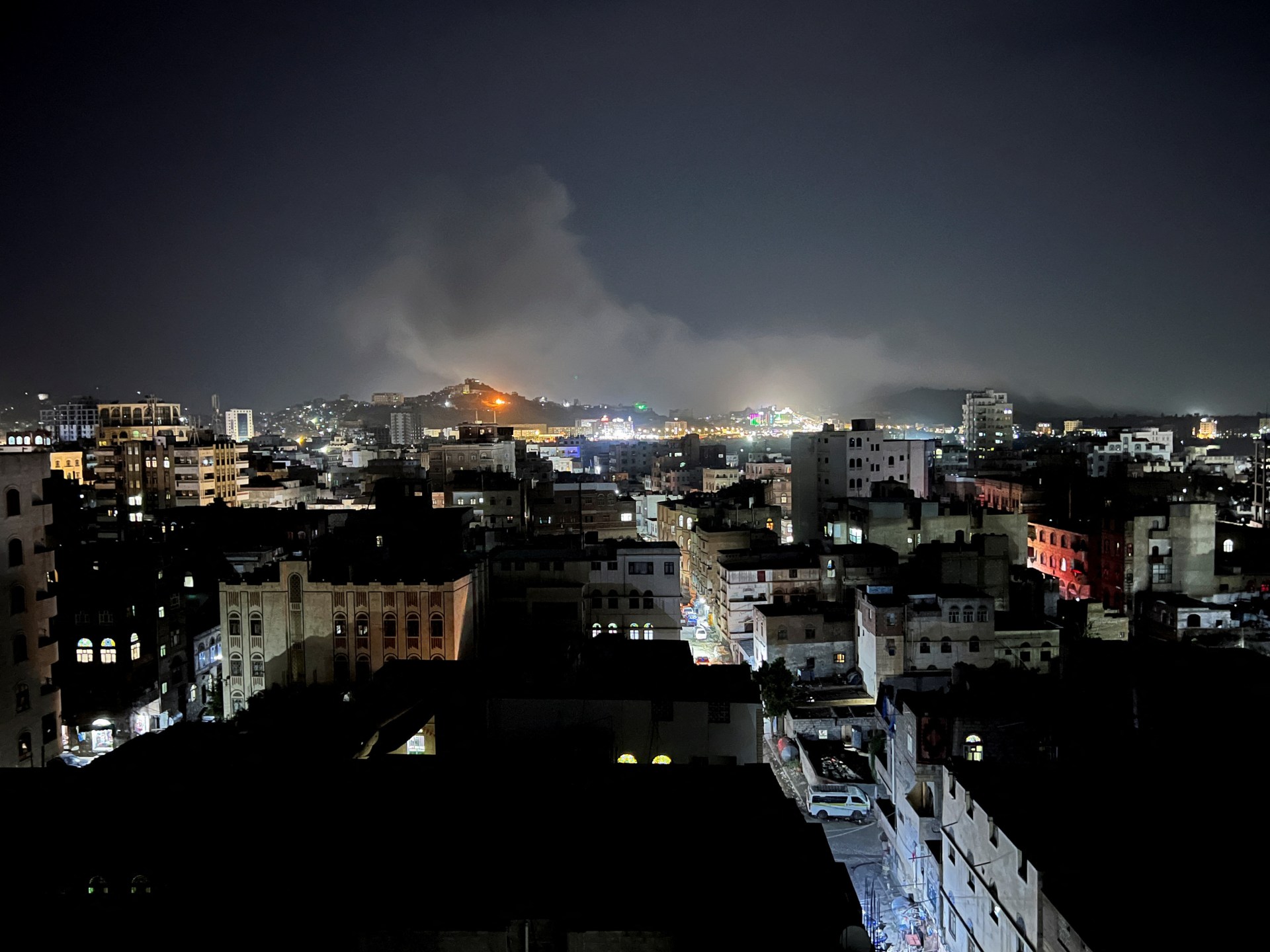
United States President Donald Trump’s administration announced a major military offensive against the Houthis a few weeks ago.
The United States has carried out more air strikes in Yemen’s capital Sanaa, after targeting Kamaran Island and Marib governorate earlier, Houthi media outlets report.
No details on casualties have been provided yet.
In Sanaa, two US airstrikes targeted the area of Attan, which has been controlled by the rebel movement since 2014. US airstrikes also reportedly targeted a sanitation project in the Asir area, as well as the Furwah neighbourhood and a popular market in the Shoub district, according to Houthi media.
The strikes on Sunday come a day after the US launched 13 strikes on Hodeidah’s port and airport, and three days after its deadliest attack to date targeted the Ras Isa port, also in Hodeidah, killing at least 80 people and wounding more than 150.
Houthi-held areas in Yemen have been subjected to near-daily air strikes by Washington. Civilians have been targeted, families wiped out, military sites destroyed and soldiers killed.
More than 200 people have been killed since US President Donald Trump’s administration announced a major military offensive against the Houthis in March. It said the air strikes are aimed at forcing the group to stop threatening ships sailing on the Red Sea on a route crucial to international trade.
Since November 2023, the Houthis have reportedly launched more than 100 attacks on vessels they say are linked to Israel in response to Israel’s war on Gaza and in solidarity with Palestinians.
Houthi attacks have paralysed shipping through the Suez Canal, a vital waterway through which approximately 12 percent of global shipping traffic normally passes, forcing many companies to resort to costly alternative routes around the Cape of Good Hope in South Africa.
The Houthis halted attacks on shipping lanes during a two-month ceasefire in Gaza earlier this year. But they vowed to resume strikes after Israel renewed its assault on the besieged enclave last month.
The Houthis, also known as Ansar Allah or “supporters of God”, emerged in the 1990s but rose to prominence in 2014 when they seized Sanaa and forced President Abd-Rabbu Mansour Hadi to flee the country.
-
Middle East2 days ago
Israeli bombardment of Gaza kills 92 in two days: Health Ministry | Israel-Palestine conflict News
-
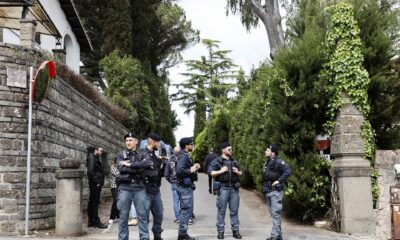
 Middle East2 days ago
Middle East2 days agoIran says progress in nuclear talks with US, confirms third round next week | News
-

 Europe2 days ago
Europe2 days agoRussia Ukraine truce: The real strategy behind Russia’s sudden truce announcement
-
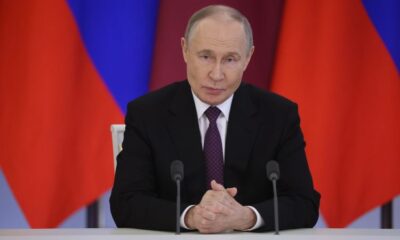
 Europe2 days ago
Europe2 days agoPutin declares brief ‘Easter truce’ in war, but Ukraine says it is still under attack
-

 Lifestyle1 day ago
Lifestyle1 day agoTariffs are likely to make having a baby cost more
-
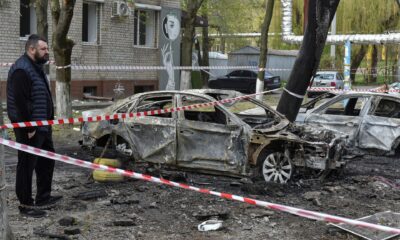
 Conflict Zones2 days ago
Conflict Zones2 days agoRussia-Ukraine war: List of key events, day 1,150 | Politics News
-
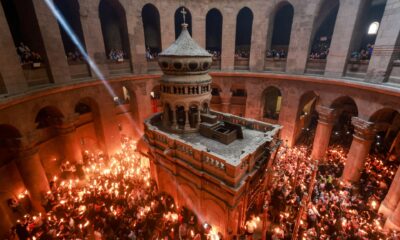
 Middle East1 day ago
Middle East1 day agoThousands gather for centuries-old Holy Fire ceremony in Jerusalem | Jerusalem News
-
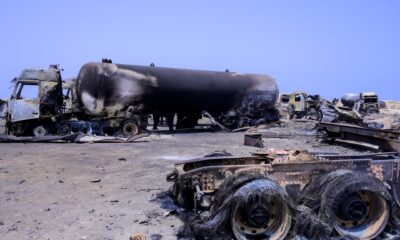
 Middle East2 days ago
Middle East2 days agoUS attacks Yemen again after at least 80 people killed in Hodeidah | Israel-Palestine conflict News



